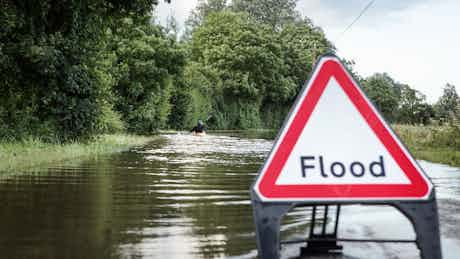Driving through floods: everything you need to know
September 24, 2024 by carwow staff

When you’re faced with driving through flood water, it’s essential to know whether your vehicle can make it through safely or not. Attempting to drive through without certainty can leave you in a hazardous situation or cause significant damage to your car.
Here’s what you need to know about driving in flood conditions, from the causes to how to navigate flood water safely. If you need to cross a ford, we’ve got that covered, too.
Driving through flood water: what causes flooding
Flood water may conjure images of submerged roads and debris, but it doesn’t take an extreme weather event to create dangerous flood conditions.
Heavy rainfall, blocked drains, river overflow, and urban development on flood plains can all contribute to flooding. It’s a hazard you could encounter even after a moderate downpour.

Driving in Heavy Rain
The presence of flood water assumes there is or has been heavy rainfall, so it’s worth running through some quick tips on this topic first.
Before even facing flood water, heavy rain itself can be hazardous. Here are a few essentials to know if you’re going to be driving in heavy rain:
Wipers and Tyres Ensure your wipers are functioning properly and your tyres have sufficient tread depth. Replace them if the tread is below 3mm. This will help maintain control in slippery conditions.
Slow Down Stopping distances are doubled in the rain, so slow down and keep a safe distance from the car in front.
Aquaplaning If your car starts to aquaplane – when water forms a barrier between your tyres and the road – gently ease off the accelerator without steering. Avoid sudden braking and let the car naturally regain traction.
Headlights On Always use headlights in poor visibility. It’s always good to actually switch your lights to on, not rely on the automatic headlight setting.
Driving through flood water: flowing water

If flood water is flowing, even a shallow depth (around 30cm) can sweep a car away. The best advice is to avoid driving through any moving water. The risks far outweigh any potential benefits.
Driving through flood water: standing water
If you encounter standing water, use caution. Don’t drive through unless you are confident your vehicle can handle it. Here’s how to proceed:
If you encounter standing water, use caution. Don’t drive through unless you are confident your vehicle can handle it. Here’s how to proceed:
1. Check the Depth Get out and use a stick to gauge the water depth. Compare this to your car’s lowest points, such as the front bumper or sills beneath the doors. If the water level is higher than this, it’s best to avoid driving through it.
2. Check for Hidden Hazards. Flood water can hide obstacles like raised drain covers or debris, which can damage your car.
3. Go one at a Time. Wait for other vehicles to pass before you proceed. If a car ahead of you gets stuck, you may find yourself in a tricky situation. Oncoming traffic can also create waves, increasing the risk.
4. Drive in the Middle. Roads are usually higher in the middle. Stick to this section to avoid soft verges or hidden obstacles.
5. Control Your Speed. Too much speed can cause water to damage your car or force it into the engine bay. Keep your speed low – around 3-4 mph – to create a bow wave that pushes water away from the vehicle.
6. Keep Your Revs High: In first gear, maintain high engine revs to prevent water from entering the exhaust. If you have an automatic car, lock into a low gear to avoid stalling.
7. Test Your Brakes. Once through the water, gently apply your brakes to clear any moisture and ensure they function correctly before you need them.
Can I drive an electric car through floods?
Modern electric vehicles (EVs) are generally well-sealed and designed to handle wet conditions. The battery and electrical components are typically housed in waterproof enclosures, making them safe for driving in moderate rain or shallow water.
However, just like with conventional vehicles, avoid deep water. If water enters critical areas, it can cause serious damage. Always check the manufacturer’s guidelines for water fording limits. After driving through standing water, be sure to check your brakes and ensure they’re working properly, as wet conditions can affect stopping performance in EVs.
Cars Change? Carwow!
Looking for a new set of wheels? With Carwow you can sell your car quickly and for a fair price – as well as find great offers on your next one. Whether you’re looking to buy a car brand new, are after something used or you want to explore car leasing options, Carwow is your one stop shop for new car deals.















